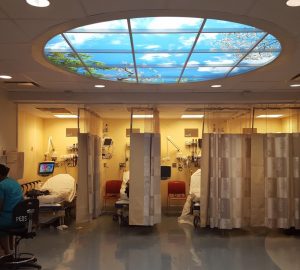Peer-reviewed publication
Publication: Critical Care Nursing Quarterly
Publication Reference: 2018 Jan/Mar;41(1):3-9
Authors: D. Kirk Hamilton, Sandy M. Swoboda, Jin-Ting Lee, Diana C. Anderson
Abstract
 There is controversy today about whether decentralized intensive care unit (ICU) designs featuring alcoves and multiple sites for charting are effective. There are issues relating to travel distance, visibility of patients, visibility of staff colleagues, and communications among caregivers, along with concerns about safety risk. When these designs became possible and popular, many ICU designs moved away from the high-visibility circular, semicircular, or box-like shapes and began to feature units with more linear shapes and footprints similar to acute bed units. Critical care nurses on the new, linear units have expressed concerns. This theory and opinion article relies upon field observations in unrelated research studies and consulting engagements, along with material from the relevant literature. It leads to a challenging hypothesis that criticism of decentralized charting alcoves may be misplaced, and that the associated problem may stem from corridor design and unit size in contemporary ICU design. The authors conclude that reliable data from research investigations are needed to confirm the anecdotal reports of nurses. If problems are present in current facilities, organizations may wish to consider video monitoring, expanded responsibilities in the current buddy system, and use of greater information sharing during daily team huddles. New designs need to involve nurses and carefully consider these issues.
There is controversy today about whether decentralized intensive care unit (ICU) designs featuring alcoves and multiple sites for charting are effective. There are issues relating to travel distance, visibility of patients, visibility of staff colleagues, and communications among caregivers, along with concerns about safety risk. When these designs became possible and popular, many ICU designs moved away from the high-visibility circular, semicircular, or box-like shapes and began to feature units with more linear shapes and footprints similar to acute bed units. Critical care nurses on the new, linear units have expressed concerns. This theory and opinion article relies upon field observations in unrelated research studies and consulting engagements, along with material from the relevant literature. It leads to a challenging hypothesis that criticism of decentralized charting alcoves may be misplaced, and that the associated problem may stem from corridor design and unit size in contemporary ICU design. The authors conclude that reliable data from research investigations are needed to confirm the anecdotal reports of nurses. If problems are present in current facilities, organizations may wish to consider video monitoring, expanded responsibilities in the current buddy system, and use of greater information sharing during daily team huddles. New designs need to involve nurses and carefully consider these issues.











 As the world becomes increasingly connected and information is freely shared, a trend toward interdisciplinary collaboration is taking place in both industry and education. This trend is highlighted by recent collaboration between clinicians and architects in both research and design. In the design of healthcare spaces, architects are working with clinicians and researchers to employ an evidence-based approach to making design decisions.
As the world becomes increasingly connected and information is freely shared, a trend toward interdisciplinary collaboration is taking place in both industry and education. This trend is highlighted by recent collaboration between clinicians and architects in both research and design. In the design of healthcare spaces, architects are working with clinicians and researchers to employ an evidence-based approach to making design decisions. Rounding is critical to developing integrated care plans, and there is a trend for moving daily rounds from the bedside to conference rooms. This study’s aim was to document staff preferences for the location of rounding practices, and to determine the effect of available space on those preferences.
Rounding is critical to developing integrated care plans, and there is a trend for moving daily rounds from the bedside to conference rooms. This study’s aim was to document staff preferences for the location of rounding practices, and to determine the effect of available space on those preferences.

